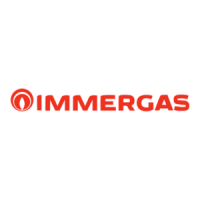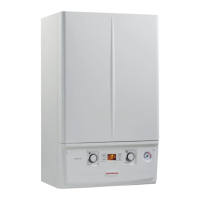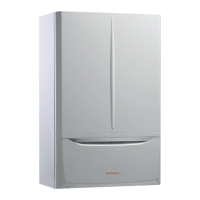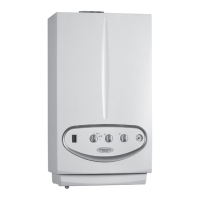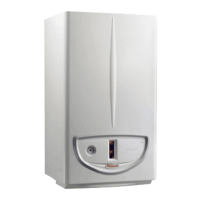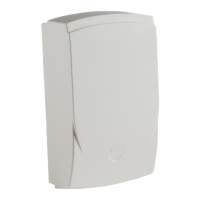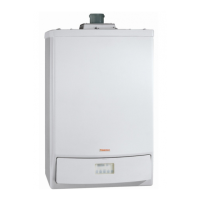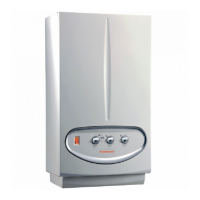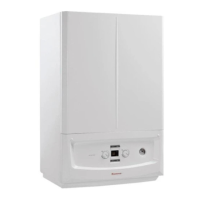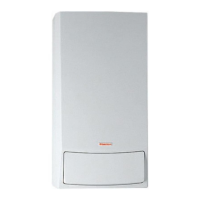1-26
C83
13 - IE
INSTALLERUSERTECHNICIAN
Immergas ducting system. e Ø60 rigid and
Ø80 exible “Green Range” ducting systems must
only be used for domestic use and with Immergas
condensing boilers.
In any case, ducting operations must respect
the provisions contained in the standard and in
current technical regulations; in particular, the
declaration of conformity must be compiled at
the end of work and on commissioning of the
ducted system. e instructions in the project
or technical report must likewise be followed, in
cases provided for by the standard and current
technical regulations. e system or components
of the system have a technical life complying with
current standards, provided that:
- it is used in average atmospheric and
environmental conditions, according to
current regulations and in particular, by the
Standard (absence of combustion products,
dusts or gases that can alter the normal
thermophysical or chemical conditions;
existence of temperatures coming within the
standard range of daily variation, etc.).
- Installation and maintenance must be
performed according to the indications
supplied by the manufacturer and in
compliance with the provisions in force.
- e max. possible length of the Ø 60 exible
ducting vertical section is equal to 22 m. is
length is obtained considering the complete
Ø 80 exhaust terminal, 1m of Ø 80 pipe in
exhaust, two 90° Ø 80 bends at boiler outlet.
- e max. possible length of the Ø 80 exible
ducting vertical section is equal to 30 m. is
length is obtained considering the complete
exhaust terminal, 1m of Ø 80 pipe in exhaust,
two 90° Ø 80 bends at boiler outlet for
connecting to the ducting system and two
direction changes of the exible tube inside
the ue/technical slot.
- e max. possible length of the Ø 60 exible
ducting vertical section is equal to 30 m. is
length is obtained considering the complete
Ø 80 exhaust terminal, 1m of Ø 80 pipe in
exhaust, two 90° Ø 80 bends at boiler outlet.
1.13 FLUE EXHAUST TO FLUE/CHIMNEY.
Flue exhaust does not necessarily have to be
connected to a branched type traditional ue.
e ue exhaust, for boiler only installed in C
conguration, can be connected to a special LAS
type multiple ue. e multiple ues and the
combined ues must also only be connected to
type C appliances of the same type (condensing),
having nominal heat inputs that do not dier by
more than 30% less with respect to the maximum
that can be attached and powered by the same
fuel. e thermo-uid dynamic features (ue
ow rate, % of carbon dioxide, % humidity etc....)
of the appliances attached to the same multiple
ues or combined ues, must not dier by more
than 10% with respect to the average boiler
attached. Multiple and combined ues must be
specially designed according to the calculation
method and requirements of the standards, by
professionally qualied technical sta. Chimney
or ue sections for connection of the exhaust
pipe must comply with requisites of technical
standards in force.
1.14 FLUES, CHIMNEYS AND CHIMNEY
CAPS.
e ues, chimneys and chimney caps for the
evacuation of combustion products must be in
compliance with applicable standards.
Positioning the exhaust terminals. e exhaust
terminals must:
- be installed on external perimeter walls of the
building;
- be positioned according to the minimum
distances specified in current technical
standards.
Combustion products exhaust of natural or
fan assisted appliances in open-top closed
environments.In spaces closed on all sides with
open tops (ventilation pits, courtyards etc.),
direct ue exhaust is allowed for conventional
or fan assisted draught gas appliances with a
heating power range from 4 to 35 kW, provided
the conditions as per the current technical
standards are respected.
1.15 SYSTEM FILLING.
Once the boiler is connected, proceed with
system lling via the lling valve (Fig. 1-28 and
2-2). Filling is performed at low speed and using
the automatic vent functions to ensure release of
air bubbles in the water via the boiler and heating
system vents.
e boiler has a built-in automatic venting valve
on the circulator. Check if the cap is loose.Open
the radiator air vent valves.
Close radiator vent valves when only water
escapes from them.
Close the lling valve when the boiler manometer
indicates approx. 1.2 bar.
N.B.: vent the circulation pump by loosening the
front cap and keeping the motor running. Re-
tighten the cap aer the operation
1.16 FILLING THE CONDENSATE TRAP.
On first lighting of the boiler combustion
products may come out the condensate drain;
aer a few minutes’ operation check that this no
longer occurs. is means that the trap is lled
with condensate to the correct level preventing
the passage of combustion products.
1.17 GAS SYSTEM STARTUP.
To start up the system, make reference to the
Standard: is divides the systems and therefore
the start-up operations into three categories: new
systems, modied systems, re-activated systems.
In particular, for new gas systems:
- open windows and doors;
- avoid presence of sparks or naked ames;
- bleed all air from pipelines;
- check that the internal system is properly sealed
according to specications.
1.18 BOILER START UP IGNITION.
For issue of the Declaration of Conformity
provided for by Italian Law, the following must
be performed for boiler start-up:
- check that the internal system is properly sealed
according to specications;
- ensure that the type of gas used corresponds to
boiler settings;
- switch the boiler on and ensure correct ignition;
- make sure that the gas ow rate and relevant
pressure values comply with those given in the
manual ( Par. 3.19);
- ensure that the safety device is engaged in the
event of gas supply failure and check activation
time;
- check activation of the master switch located
upstream from the boiler and in the boiler;
- check that the concentric intake-exhaust
terminal (if tted) is not blocked.
e boiler must not be started up even if only
one of the checks should be negative.
N.B.: e boiler preliminary check must be carried
out by a qualied technician. e conventional
boiler warranty is valid as of the date of testing.
e test certicate and warranty is issued to the
user.
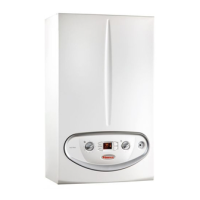
